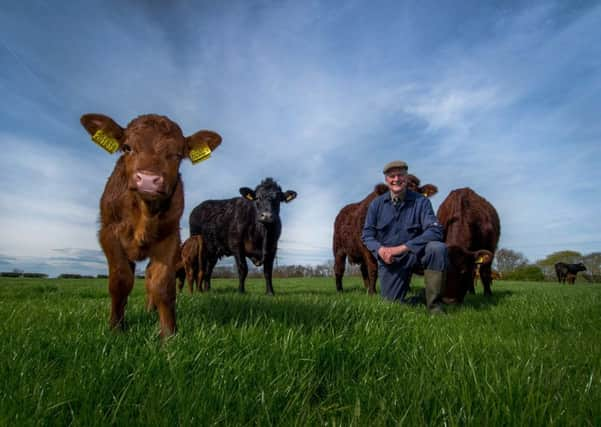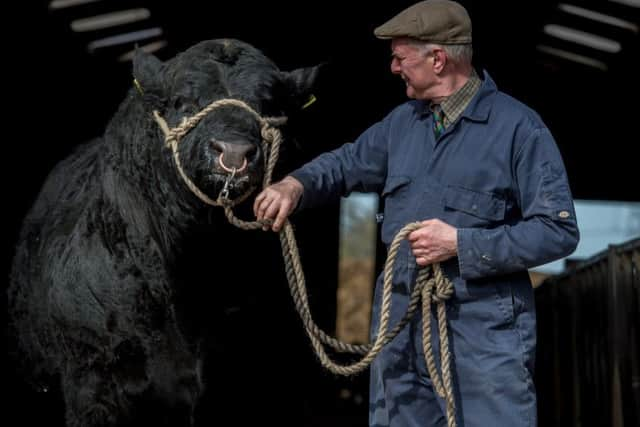Farm of the Week: Salers are proving a breed apart near Yarm


It is a rise that appears to be on a steady incline judged by statistics sourced from the BCMS (British Cattle Movement Service) and one that Terence Pye who farms at Leven Fields in Middleton-on-Leven, near Yarm, believes will continue.
Terence and his wife Jane talent spotted the Salers potential in the mid/late 80s. Their Rigel herd is now one of the country’s best known and in November Terence became chairman of the Salers Cattle Society. He’s delighted with the breed’s progress particularly in the past five years.
Advertisement
Hide AdAdvertisement
Hide Ad“We have always believed that the Salers has a very unique set of traits that suit the British farmer’s needs, so this is a bit of a mission as well as a business to make everyone aware of its benefits, specifically its easy calving.


“When you consider what the Charolais breed brought to Britain in the 1960s we think the Salers are doing the same for the suckler cow sector and what is happening presently is a really exciting shift of gear in the number of farmers who are realising just that.
“We feel the Salers knock spots off other breeds for easy calving. All of our calves are born in the mid-30 kilos range and with the cows having such huge pelvic areas the calves fly out. Last year we had 66 Salers calves, of which there were four sets of twins, and every birth was unassisted.”
In the headlong rush that often exists among commercial beef producers to achieve the target finishing weights as soon as possible a high birth weight can be seen as the ideal kick-start. Terence feels this is short-termism that can ultimately kick things back rather than forward.
Advertisement
Hide AdAdvertisement
Hide Ad“Pressures on farming are forcing a much more careful attitude to cost and time. Difficult births inevitably lead to greater vet bills, loss of calves, poorer longevity of cows and wasted time. The message about Salers has reached the next stage where the commercial suckler cow herdsmen and women now know what the breed can do and those that haven’t yet taken them on are finding their neighbours who have done so are happy with them. It’s all about performance, they’re not necessarily the most muscly animal, but they do what the market demands.


“It is important for the breed that we manage the success. We’re getting new people coming in all the time as the growing membership of the society bears out and it is vital we make sure that everyone knows enough about the breed so that it doesn’t get spoilt. It has certainly caught the mood of the industry, largely because of easy calving and I’m urging new members and those who are considering Salers to value low birth weight.
“Our goal here at Leven Fields has always been to produce the ideal stock for the commercial beef producer. If we sell to a pedigree breeder that’s nice but the vast amount of ours go to commercial beef herds where they have become tired of having to pull calves out of their mothers. About half of our customers come because of easy calving and that includes dairy farmers, with around a quarter to one-third of our bulls being sold into dairy herds.
“The other half want females because they have seen what they can do, realise they can’t buy them easily and as a result can be expensive. That’s why more farmers are coming into the breed, to breed their own.
Advertisement
Hide AdAdvertisement
Hide Ad“The society has implemented the breed plan system that allows the correct criteria to be set for the years to come and we now have EBV figures (estimated beef values) that means producers can select bulls for low to moderate birth weights. We’ve also worked hard, particularly here at home, on producing polled cattle that command a premium.”
Neither Terence nor Jane had a family farming background. Terence was raised in the London suburb of Caterham near Croydon and worked for ICI, which brought him to Teesside. Jane is from Bilston in the Black Country and had a nursing career.
“My brother, Malcolm was interested in farming and had taken on a small farm in Nottinghamshire, where he had cattle. Jane and I looked after them when he and his wife Gillian went on holiday. We found out that we loved cows and saw the Salers as the ideal breed.
“The four of us then had this idea of setting up in business together and in 1991 both couples sold up our respective homes and came here buying 90 acres and the farm buildings. We were immensely fortunate to take on Jim Ridley who had worked on the farm for the previous owner and is still with us today.
Advertisement
Hide AdAdvertisement
Hide Ad“We were also lucky that additional land came up adjacent to us, and that we purchased taking us to the 208 acres we have today. Apart from 30 acres of woodland it is all down to grass and one of our borders is a one and a half mile stretch of the River Leven.”